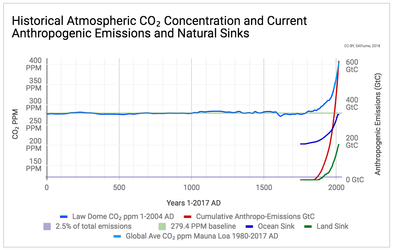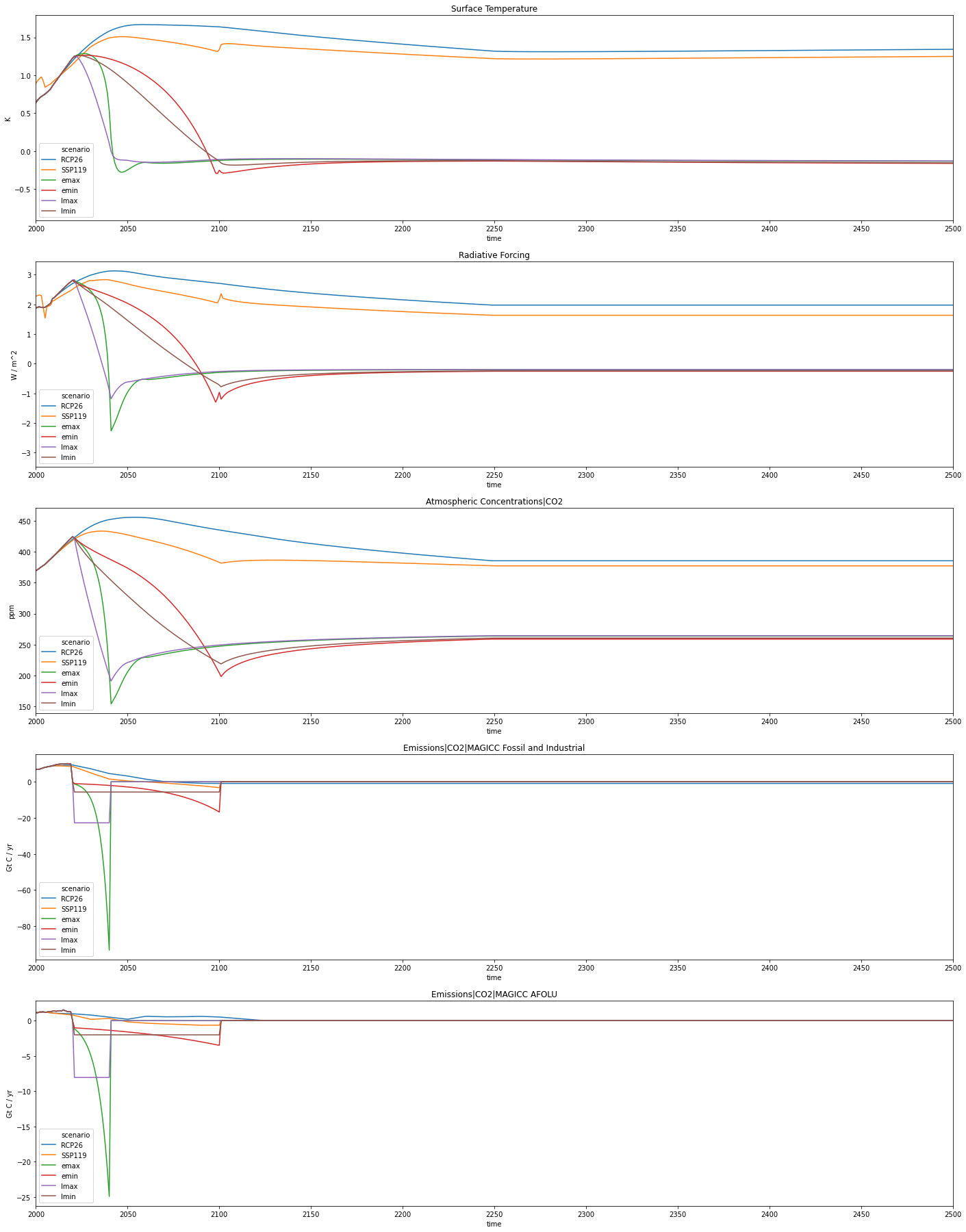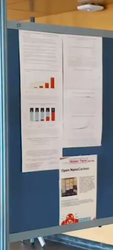| Table of Contents |
|---|
Summary
Status
The main paper is on hold till I secure funding. Experiments to test 300 ppm, then to 280 ppm, and calibrating MAGICC 6.8 for removal are in progress.
The full experimental paper is on hold until the experiments can be rerun on a full CDRMIP Atmosphere-Ocean General Circulation Model, such as MPI-ESM. Once the experiments are run on a full AOGCM the results will more accurately (compared to a Reduced-complexity Model such as MAGICC 6.8) show if the hypothesis of halting anthropogenic emissions from all greenhouse gasses and additionally remove cumulative anthropogenic carbon dioxide, would restore the climate to that existed at 1800 with a CO₂ concentration of about 280 ppm.
Alternatively, the Reduced Complexity Model results could be submitted as a letter or commentary to a journal. This would allow for minor funding. However, its impact would be minimal as the experiments would need to be repeated on a cluster running the full AOGCM to better understand the accuracy as MAGICC6 was not calibrated for large scale Carbon removalDescription
Model large-scale carbon dioxide removal and greenhouse gas phase-outs to verify temperature achieving close to 0ºC over the mean global temperature of 1850-1900 by 2100.
This paper runs a multi-step experiment on the climate model emulator (or reduced complexity model) MAGICC 6.8 to provide rationale for further exploration within an Earth System Model (ESM) to better project the climate under modest feedbacks while realizing final temperature evolution to match pre-industrial.
ONC doesn't have the funds or resources to run the experiments on a newer CDRMIP class Atmosphere-Ocean General Circulation Model (AOGCM).
About These Papers
These papers were conceived by Shannon A. Fiume in late 2017 during a conversation with Peter Fiekowsky as she was unable to find in the literature a way to return to the preindustrial climate within a hundred years of the present date while verifying how much carbon could be removed by scaled CDR in an exponential manner. By backtracking to the larger scoped question, if we were to target a lower temperature or preindustrial itself, this new goal could add an additional pathway to a more restored climate. Potentially this new goal could help limit damages by providing more literature for reducing emissions faster in the near term. Given the scientific gap, this project then shifted from a goal for ONC of what is the upper bound of carbon we ought to remove to the larger question of how much carbon would humans need to remove or have completed by 2100 in order to shift the climate back as close as possible to 0ºC over pre-industrial. See Shannon Fiume's comments on the CDR mailing list and Twitter for her conversations with the CDR community.
These papers are scoping exercises and technology-agnostic and as such, don't inherently fall into the category of presenting a Moral Hazard. To be more explicit, to achieve net-zero the fastest, mitigate a high-risk climate, limit further ecological loss and damages, and prepare to scale (fossil fuel-less) negative emissions for the next 70 years, it's necessary to have fossil fuels phased out as soon as possible and as such fossil fuels are therefore inappropriate to be used as a scaled source to generate net-zero or net-negative emissions. Humans have too many cumulative emissions to remove (think of running the carbon budget in reverse) to also add new emissions in any sizeable quantity.
Papers
Theory paper
Presented version: Targeting All Anthropogenic Carbon Dioxide Emissions (2018)
PrePrint (non-peer-reviewed) Revised version: Carbon Dioxide Removal Estimation Method to Remove Cumulative Anthropogenic CO₂ Emissions Distribution to Natural Sinks (2018, 2023), Alternative Method to Determine a Carbon Dioxide Removal Target (2018)
https://doi.org/10.1002/essoar.10503117.1
AuthorsAuthor: Shannon A. Fiume
Short Description: A short paper outlining how much carbon we need to solidify for complete climate restoration and the carbon's location. Shows It shows why 300 ppm and less needs need to be fully explored for complete climate restoration.
Experimental Validation Paper
Working draft title 'Modeling of large scale CDR Scenarios'.
Experimental validation of Targeting All Anthropogenic Carbon Dioxide Emissions with MAGICC 6, and pymagicc.
Authors: Shannon A. Fiume
Abstract
The experiments explore the effects of halting anthropogenic emissions from all greenhouse gasses and additionally removing cumulative anthropogenic carbon dioxide in less than 100 years. Two pairs of idealized greenhouse gas emissions modeling experiments were completed in MAGICC 6.801, a Reduced Complexity Model. The experiment pair explores the difference between exponential removal and linear removal for both a forty- and eighty-year time frame. Results were graphed, extending to 2500, showing a converging temperature, greenhouse concentration, and warming. The Reduced Complexity climate model, when all greenhouse gas emissions were halted, and cumulative anthropogenic carbon dioxide was removed, excluding ammonia under .1ºC of warming was realized.
Results Summary
The experiments removed all anthropogenic carbon dioxide and forced all other GHGs to zero, excluding ammonia, which resulted in under .1ºC of warming.
Graphs of Experiment Scenarios
CO₂ ppm
CO₂-eq ppm
CO₂ RF W/m²
Total Anthro RF W/m²
Global Temp ºC
278.4
277.4
0.0268
-0.0244
0.0771
278.9
277.8
0.037
-0.0171
0.0825
273.6
275.3
-0.0655
-0.0653
0.0546
275.9
276.4
-0.0206
-0.0424
0.0719
Mean
276.7
276.7
-0.0056
-0.0373
0.0715
Std dev
1.9
0.9
0.0375
0.0166
0.0085
Pymagicc output: Shows SSP-1 1.9 in orange. The graphing artifacts for SSP 1 1.9 are due to errors in the dataset from bugs in pymagicc and ipcc explorer data output. The raw MAGICC output is also shown in the links to the Graphs of Experiment Scenarios above.
Data Area
CSV of control files (Also see the SCENemax, SCENlmax, etc. tabs in Total Emitted Carbon Graphs and Comparisons gsheets)
- EMAX - https://drive.google.com/open?id=1ixSjWiY4vZ5wGMTBdQZvSfpA9Xa-wkZi
- LMAX https://drive.google.com/open?id=165v1m4NYZ9H2krOxFIJiAgsMCwbxSb_F
- EMIN - https://drive.google.com/open?id=1ldRhdefresrCUeedRyO5QqUcB4U1LASA
- LMIN - https://drive.google.com/open?id=1CUn6_xZeT7z9FcQP9NIH9mhdUsvQFemJ
SCEN Control files
Code Area
CDR Modeling Experiment Github repository: https://github.com/hsbay/cdrmex
Dependencies
- wine - Wine Is Not an Emulator, emulation software for running Windows programs on Linux and Unixes including MacOS
- pymagicc
Pymagicc will install the following:
MAGICC 6.801
jupyter
Code to translate CSVs and display scenarios are forthcoming.
SSP Database, International Institute for Applied Systems Analysis: https://tntcat.iiasa.ac.at/SspDb, About page
Bugs
Reference Papers
Emulating coupled atmosphere-ocean and carbon cycle models with a simpler model, MAGICC6 – Part 1: Model description and calibration, Meinshausen, M., Raper, S. C. B., and Wigley, T. M. L., Atmos. Chem. Phys., 11, 1417-1456, DOI: 10.5194/acp-11-1417-2011, 2011
Emulating atmosphere-ocean and carbon cycle models with a simpler model, MAGICC6 – Part 2: Applications, Meinshausen, M., Wigley, T. M. L., and Raper, S. C. B., Atmos. Chem. Phys.,11, 1457–1471, DOI: 10.5194/acp-11-1457-2011, 2011
Global Carbon Budget 2017Currently in process of seeking additional funding for Open Access publication, needs to be resubmitted to a journal.
ExperimentalValidationPaper
Speculative scaled carbon removal modeling to return to preindustrial temperatures by 2100.
Experiments performed in collaboration with Foundation for Climate Restoration. Experiments to test how to achieve 300 ppm, then 280 ppm.
Author: Shannon A. Fiume
Shannon to present the findings of the paper and broader aspects of seeking climate restoration presented at a poster session at the AGU 2023.
Presented AGU-posterprint.pdf: Novel, speculative highly-scaled carbon removal study on a reduced complexity model, showing a return to preindustrial temperatures by 2100 and updates to achieving net-zero for Anthropocene reversal, B43K-2705, presented at AGU, 11-15 Dec. 2023, DOI: 10.22541/essoar.170365323.31209497/v1
Paper has still not been peer-reviewed currently in process of seeking additional funding for Open Access publication.
Related References
Global Carbon Budget 2017, 2018, Le Quéré, C., Andrew, R. M., Friedlingstein, P., Sitch, S., Pongratz, J., Manning, A. C., Korsbakken, J. I., Peters, G. P., Canadell, J. G., Jackson, R. B., Boden, T. A., Tans, P. P., Andrews, O. D., Arora, V. K., Bakker, D. C. E., Barbero, L., Becker, M., Betts, R. A., Bopp, L., Chevallier, F., Chini, L. P., Ciais, P., Cosca, C. E., Cross, J., Currie, K., Gasser, T., Harris, I., Hauck, J., Haverd, V., Houghton, R. A., Hunt, C. W., Hurtt, G., Ilyina, T., Jain, A. K., Kato, E., Kautz, M., Keeling, R. F., Klein Goldewijk, K., Körtzinger, A., Landschützer, P., Lefèvre, N., Lenton, A., Lienert, S., Lima, I., Lombardozzi, D., Metzl, N., Millero, F., Monteiro, P. M. S., Munro, D. R., Nabel, J. E. M. S., Nakaoka, S.-I., Nojiri, Y., Padin, X. A., Peregon, A., Pfeil, B., Pierrot, D., Poulter, B., Rehder, G., Reimer, J., Rödenbeck, C., Schwinger, J., Séférian, R., Skjelvan, I., Stocker, B. D., Tian, H., Tilbrook, B., Tubiello, F. N., van der Laan-Luijkx, I. T., van der Werf, G. R., van Heuven, S., Viovy, N., Vuichard, N., Walker, A. P., Watson, A. J., Wiltshire, A. J., Zaehle, S., and Zhu, D., Earth System Science Data, 10, pp. 405-448, DOI: 10.5194/essd-10-405-2018,2018
The Shared Socioeconomic Pathways and their energy, land use, and greenhouse gas emissions implications: An overview, Keywan Riahi, Detlef P. van Vuuren, Elmar Kriegler, Jae Edmonds, Brian C. O’Neill, Shinichiro Fujimori, Nico Bauer, Katherine Calvin, Rob Dellink, Oliver Fricko, Wolfgang Lutz, Alexander Popp, Jesus Crespo Cuaresma, Samir KC, Marian Leimbach, Leiwen Jiang, Tom Kram, Shilpa Rao, Johannes Emmerling, Kristie Ebi, Tomoko Hasegawa, Petr Havlík, Florian Humpenöder, Lara Aleluia Da Silva, Steve Smith, Elke Stehfest, Valentina Bosetti, Jiyong Eom, David Gernaat, Toshihiko Masui, Joeri Rogelj, Jessica Strefler, Laurent Drouet, Volker Krey, Gunnar Luderer, Mathijs Harmsen, Kiyoshi Takahashi, Lavinia Baumstark, Jonathan C. Doelman, Mikiko Kainuma, Zbigniew Klimont, Giacomo Marangoni, Hermann Lotze-Campen, Michael Obersteiner, Andrzej Tabeau, Massimo Tavoni, Global Environmental Change, Volume 42, Pages 153-168, ISSN 0959-3780, DOI: 110.1016/j.gloenvcha.2016.05.009, 2017
Energy, land-use and greenhouse gas emissions trajectories under a green growth paradigm, SSP1: Detlef P. van Vuuren, Elke Stehfest, David E.H.J. Gernaat, Jonathan C. Doelman, Maarten van den Berg, Mathijs Harmsen, Harmen Sytze de Boer, Lex F. Bouwman, Vassilis Daioglou, Oreane Y. Edelenbosch, Bastien Girod, Tom Kram, Luis Lassaletta, Paul L. Lucas, Hans van Meijl, Christoph Müller, Bas J. van Ruijven, Sietske van der Sluis, Andrzej Tabeau, Global Environmental Change, Volume 42, Pages 237-250, ISSN 0959-3780, DOI 10.1016/j.gloenvcha.2016.05.008, 2017
Target atmospheric CO2
Target atmospheric CO2: Where should humanity aim?, 2008, Hansen, J., M. Sato, P. Kharecha, D. Beerling, R. Berner, V. Masson-Delmotte, M. Pagani, M. Raymo, D.L. Royer, and J.C. Zachos, Open Atmos. Sci. J., 2, 217-231, DOI: 10.2174/1874282300802010217, 2008
Related Papers
The Carbon Dioxide Removal Model Intercomparison Project (CDR-MIP): Rationale and experimental protocol for CMIP6, Keller, D. P., Lenton, A., Scott, V., Vaughan, N. E., Bauer, N., Ji, D., Jones, C. D., Kravitz, B., Muri, H., and Zickfeld, K., Geosci. Model Dev., DOI: 10.5194/gmd-2017-168, 2018.
The SSP greenhouse gas concentrations and their extensions to 2500, Meinshausen, M., Nicholls, Z., Lewis, J., Gidden, M. J., Vogel, E., Freund, M., Beyerle, U., Gessner, C., Nauels, A., Bauer, N., Canadell, J.P., Daniel, J.S., John, A.,Krummel, P., Luderer, G., Meinshausen, N., Montzka, S., Rayner, P., Reimann, S., Smith, S.J., van den Berg, M.,Velders, G.J.M., Vollmer, M., Wang, H.J.R., DOI: 10.5194/gmd-2019-222, 2019 (preprint)Projecting Antarctica’s contribution to future sea level rise from basal ice-shelf melt usinglinear response functions of 16 ice sheet models (LARMIP-2), Levermann,A., Winkelmann, R.,Albrecht, T., Goelzer, H., Golledge, N.R., Greve, R., Huybrechts, P., Jordan, J., Leguy, G., Martin, D., Morlighem, M., Pattyn, F., Pollard, D., Quiquet, A., Rodehacke, C., Seroussi, H., Sutter, J., Zhang, T., Van Breedam, J., DeConto, R., Dumas, C., Garbe, J., Gudmundsson, G.H., Hoffman, M.J., Humbert, A., Kleiner, T., Lipscomb, W., Meinshausen, M., Ng, E., Perego, M., Price, S.F., Saito, F., Schlegel, N., Sun, S., van de Wal, R.S.W., DOI: 10.5194/esd-2019-23, 2020Reduced Complexity Model Intercomparison Project Phase 1:introduction and evaluation of global-mean temperature response, https://doi.org/10.5194/gmd-13-5175-2020
Zebedee R. J. Nicholls1,2, Malte Meinshausen1,2,3, Jared Lewis1, Robert Gieseke4, Dietmar Dommenget5,Kalyn Dorheim6, Chen-Shuo Fan5, Jan S. Fuglestvedt7, Thomas Gasser8, Ulrich Golüke9, Philip Goodwin10,Corinne Hartin6, Austin P. Hope11, Elmar Kriegler3, Nicholas J. Leach12, Davide Marchegiani5, Laura A. McBride13,Yann Quilcaille8, Joeri Rogelj8,14, Ross J. Salawitch11,13,15, Bjørn H. Samset7, Marit Sandstad7,Alexey N. Shiklomanov6, Ragnhild B. Skeie7, Christopher J. Smith8,16, Steve Smith6, Katsumasa Tanaka17,18,Junichi Tsutsui19, and Zhiang Xie
Is there warming in the pipeline? A multi-model analysis of the Zero Emissions Commitment from CO₂, https://doi.org/10.5194/bg-17-2987-2020
Andrew H. MacDougall1, Thomas L. Frölicher2,3, Chris D. Jones4, Joeri Rogelj5,6, H. Damon Matthews7,Kirsten Zickfeld8, Vivek K. Arora9, Noah J. Barrett1, Victor Brovkin10,11, Friedrich A. Burger2,3, Micheal Eby12,Alexey V. Eliseev13,14, Tomohiro Hajima15, Philip B. Holden16, Aurich Jeltsch-Thömmes2,3, Charles Koven17,Nadine Mengis18, Laurie Menviel19, Martine Michou20, Igor I. Mokhov13,14, Akira Oka21, Jörg Schwinger22,Roland Séférian20, Gary Shaffer23,24, Andrei Sokolov25, Kaoru Tachiiri15, Jerry Tjiputra22, Andrew Wiltshire4, andTilo Ziehn2
A solution to the misrepresentations of CO2-equivalent emissions of short-lived climate pollutants under ambitious mitigation, Myles R. Allen, Keith P. Shine, Jan S. Fuglestvedt, Richard J. Millar, Michelle Cain, David J. Frame & Adrian H. Macey, npj Climate and Atmospheric Science, volume 1, Article number: 16, DOI: 10.1038/s41612-018-0026-8, 2018
, PNAS, , DOI: 10.1073/pnas.1810141115, 2018
Estimating Changes in Global Temperature since the Preindustrial Period, Ed Hawkins, Pablo Ortega, Emma Suckling, Andrew Schurer, Gabi Hegerl, Phil Jones, Manoj Joshi, Timothy J. Osborn, Valérie Masson-Delmotte, Juliette Mignot, Peter Thorne, and Geert Jan van Oldenborgh, DOI: 10.1175/BAMS-D-16-0007.1, 2017


